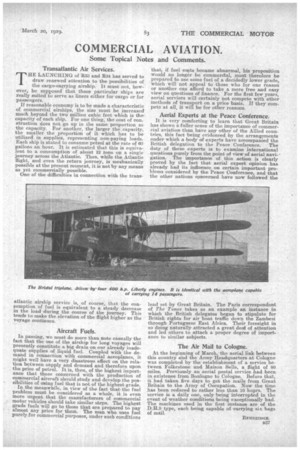COMMERCIAL AVIATION.
Page 17

If you've noticed an error in this article please click here to report it so we can fix it.
Some Topical Notes and Comments.
Transatlantic Air Services.
THE LAUNCHING of R33 and R34 has served to draw renewed attention to the possibilities of the cargo-carrying airship. It must not, however, be supposed that these particular ships are really suited to serve as liners either for cargo or for passengers.
If reasonable economy is to be made a characteristic of commercial airships, the size must be increased much beyond the two million cubic feet which is the capacity of each ship. For one thing, the cost of construction does not go up in the same proportion as the capacity. For another, the larger the capacity, the smaller the proportion of it which has to be utilized in supplies, representing non-paying loads. Each ship is stated to consume petrol at the rate of 60 gallons an hour. It is estimated that this is equivalent to a consumption of about 12 tons on a single journey across the Atlantic. Thus, while the Atlantic flight, and even the return journey, is mechanically possible at the present moment, it is not by any means as yet commercially possible.
One of the difficulties in connection with the trans
atlantic airship service is, of course, that the consumption of fuel is equivalent to a steady decrease in the load during the courae of the journey. This tends to make the elevation of the flight higher as the voyage continues.
Aircraft Fuels.
In passing, we must do more than note casually the fact that the use of the airship for long voyages will presently constitute a big drain on our already inadequate supplies of liquid fuel. Coupled with the demand in connection with commercial aeroplanes, it might well have a very disastrous effect on the relation between supply and demand and therefore upon the price of petrol. It is, then, of the highest importance that those concerned with the production of commercial aircraft should study and develop the possibilities of using fuel that is not of the highest grade. In the meanwhile, in view of the fact that the fuel problem must be considered as a whole, it is even more urgent that the manufacturers of commercial motor vehicles should take similar steps. The highest grade fuels will go to those that are prepared to pay almost any price for them. The man who uses fuel purely for commercial purposes, under such conditions that, if fuel costs became abnormal, his proposition would no longer be commercial, must therefore be prepared to use some fuel of a decidedly lower grade, which will not appeal to those who for one reason or another can afford to take a more free and easy view on questions of finance. For the first few years, aerial services will certainly not compete with other methods of transport on a price basis. If they compete at all, it will be for other reasons.
Aerial Experts at the Peace Conference.
It is very comforting to learn that Great Britain has shown a fuller sense of the importance of commercial aviation than have any other of the Allied countries, this fact being evidenced by the arrangements under which a body of experts have accompanied the British delegation to the Peace Conference. The duty of these experts is to examine international questions purely from the point of view of aerial navigation. The importance of this action is clearly proved by the fact that aerial expert opinion has already had its influence on certain important problerns considered by the Peace Conference, and that the other nations concerned have now followed the
lead set by Great Britain. The Paris correspondent of The Times takes as an example an instance in which the British delegates began to stipulate for British rights for air boat traffic down the Zambesi through Portuguese East Africa. Their foresight in, so doing naturally attracted a great deal of attention and led others to attach a proper degree of importanee to similar subjects.
The Air Mail to Cologne.
At the beginning of March,the aerial link between this country and the Army Headquarters at Cologne was completed by the establishment of a service between Folkestone and Maison Selle, a flight of 80 miles. Previously an aerial postal tervice had been in existence from Boulogne to Cologne. Before that, it had taken five days to get the mails from Great Britain to the Army of Occupation. Now the time has been reduced to rather less than 10 hews. The service is a daily one, only being interrupted in the event of weather conditions being exceptionally bad. The machines used in the first instance are of the D.H. type, each being capable of carrying six 'bags of mail.
BE NIERIDGE.






















